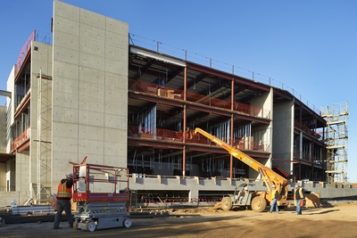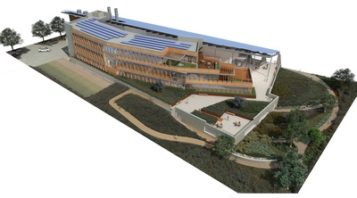
SAN DIEGO, Calif. — McCarthy has recently topped off the last concrete pour for the J. Craig Venter Institute on The University California, San Diego campus. Completion is slated for later this year.
Zimmer Gunsul Frasca Architects has designed he three-story, 45,000-square-foot laboratory facility.
Expected to be the most environmentally friendly and only “net-zero energy” biological laboratory in the world, the new $39-million J. Craig Venter Institute will support approximately 125 scientists and other staff in their mission to further the institute’s goals in genomic research and policy. The location of the facility, on land leased from UCSD at the Scripps Upper Mesa, was chosen for its proximity to and potential for collaboration with the many renowned academic research centers in the La Jolla area.
“The project team is targeting LEED-Platinum certification,” said Robert Friedman, director of the J. Craig Venter Institute’s California campus. “Through rigorous LEED tracking and high performance teaming, McCarthy has successfully maintained a smooth construction process and kept the project on schedule toward our targeted November 2013 completion date.”
The new J. Craig Venter Institute will be one building consisting of a single-story, 12,605-square-foot laboratory wing; a three-story, 28,600-square-foot office wing; a 3,560-square-foot loading dock area and a partially below-grade parking garage. The laboratory and office wings will sit atop the roof/podium deck of the parking garage. Exterior features include cedar wood siding, a wood window curtainwall and storefront system, metal panels, interior wood flooring and exposed architectural concrete.
The concrete walls, columns, footings, slab on grade, slabs on metal deck and podium deck utilize 30 percent fly ash. Use of the high fly ash content contributes to two LEED points in the category of “recycled content.” For optimum aesthetic appeal, the exposed architectural walls and columns use Type III cement. McCarthy self-performed all the concrete work.
“McCarthy has achieved notable success on other projects such as the Salk Institute, UCSD Student Academic Services Facility and Soka University in Orange County, where the quality of the concrete work was essential,” said McCarthy Project Manager Nate Ray. “For the J. Craig Venter Institute, we had the advantage of drawing on the expertise of the same concrete specialist who oversaw work on the Salk Institute, as well as the same ZGF design team we worked with on the Soka University project.”
Advanced technology is playing a key role in this project. The project team is utilizing BIM, Navis Works and Blue Beam for the electrical plan room, as well as FTP sites that are allowing the team to be paperless throughout the LEED certification process.
To meet the client’s goal of creating the most sustainable laboratory in the world, the facility incorporates high-performance architecture, low-energy use systems, water conservation strategies and onsite renewable power generation. The building massing and envelope are designed to maximize the use of daylight, while reducing overall building energy use. Being net-zero for electrical energy, the building will produce as much electricity onsite as it consumes annually. This will be made possible by integrating numerous energy-efficiency measures throughout the building systems, using advanced building control technologies, incorporating operable windows and efficient lighting and by reducing internal plug loads wherever possible.
Onsite renewable energy will be generated through the sizeable photovoltaic roof. The project team has also pursued aggressive water conservation based on the combined strategies of infiltration and water reuse. Rainwater will be collected and stored in giant underground cisterns with a total capacity of 90,000 gallons. The water will then be filtered and reused for operation of cooling towers, toilet flushing and site irrigation. About two-thirds of the building’s water use will be supplied by rainwater.
Other sustainable design strategies include recycled content, natural ventilation and passive cooling, low-water landscaping, high-efficiency plumbing, sustainably harvested wood and use of regional materials, the latter of which is helping to keep costs down.
“McCarthy was brought in early to perform preconstruction on this project with the purpose of significantly lowering construction costs, while still allowing the client to aim for LEED-Platinum status,” said McCarthy Project Director Craig Swenson. “This target value-design approach is enabling us to maintain the integrity of the highly sustainable design, while also making the budget work.”
KPFF Consulting Engineers is the structural and civil engineer; Integral Group is the mechanical, electrical and plumbing engineer; Jacobs Consultancy is the laboratory planner; Andropogon Associates and David Reed are the landscape architects; SC Engineers are designing building controls; David Nelson & Associates is the lighting design consultant and Sustainable SoCal is the construction manager.




 Join our thriving community of 70,000+ superintendents and trade professionals on LinkedIn!
Join our thriving community of 70,000+ superintendents and trade professionals on LinkedIn! Search our job board for your next opportunity, or post an opening within your company.
Search our job board for your next opportunity, or post an opening within your company. Subscribe to our monthly
Construction Superintendent eNewsletter and stay current.
Subscribe to our monthly
Construction Superintendent eNewsletter and stay current.